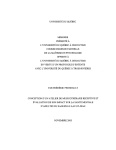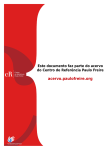Download Références
Transcript
155
Références
156
Agrotou, A. (1993). Music Therapy in Cyprus. Dans C. Maranto (Éd.), Music
Therapy : International Perspectives (183-196). Pipersville, PA : Jeffrey Books.
Alley, J. (1979). Music in the IEP : Therapy-education. Journal of Music Therapy, 16
(3), 111-127.
Alvin, J. (1975). Music Therapy (Revised Paperback Edition). London : John Clare
Books.
American Psychiatric Association.
(1996). DSM-IV: Manuel diagnostique et
statistique des troubles mentaux (4eme éd.) (version internationale) (Washington,
DC, 1995). Traduction française par J.D. Guelfi et al., Paris : Masson.
Assabgui, J. (1990). La musicothérapie. Paris : Jacques Grancher éditeur.
Axelson, D. A., & Birmaher, B. (2001). Relations between anxiety and depressive
disorders in childhood and adolescence. Depression and Anxiety, 14(2), 67-78.
Bachman, J. G. (1982). Family relationships and self-esteem. Dans M. Rosenberg, &
H. B. Kaplan (Éds), Social Psychology of the Self-Concept (pp. 356-364).
Arlington Heights (IL) : Harlan Davidson.
Bang, C. (1986). A World of Sound and Music. Music Therapy and Musical Speech
Therapy with Hearing-impaired and Multiple-handicapped Children. Dans E.
Ruud (Éd.), Music and Health (pp. 19-36). Oslo, Norway: Norsk Musikforlag.
Barcellos, L. (1982). Music as a Therapeutic Element. Paper presented at the First
International Symposium on Music and Man. New York University, June 1982,
New York City.
Beck, A. T. (1973). The diagnosis and management of depression.
University of Pennsylvania Press.
Philadelphia :
Ben Amar, M. (2002). Anxiolytiques, sédatifs et hypnotiques. Dans L. Léonard, & M.
Ben Amar (Éds), Les psychotropes. Pharmacologie et toxicomanie (pp. 165-220).
Montréal : Les Presses de l'Université de Montréal.
157
Blake, R. L. (1994). Vietnam veterans with post-traumatic stress disorder : Findings
from a music and imagery project. Journal of the Association for Music and
Imagery, 3, 5-17.
Blake, R. L., & Bishop, S. R. (1994). The Bonny Method of Guided Imagery and Music
(GIM) in the Treatment of Post-Traumatic Stress Disorder (PTSD) with Adults in
the Psychiatric Setting. Music Therapy Perspectives, 12, 125-129.
Bonde, L. O. (1997). Music Analysis and Image Potentials in Classical Music. Nordic
Journal of Music Therapy, 7(2), 121-128.
Bonny, H. L. (1978a). Facilitating Guided Imagery and Music sessions: GIM
Monograph no. 1, Baltimore (Maryland): ICM Books.
Bonny, H. L. (1978b). The Role of Taped Music Programs in the GIM Process : Theory
and Product. GIM Monograph no. 2, Baltimore (Maryland): ICM Books.
Bonny, H. L. (1980). GIM Therapy: Past, Present and Future Implications.
Monograph no. 3, Baltimore (Maryland): ICM Books.
GIM
Bonny, H. L. (1986). Music And Healing. Music Therapy: Journal of the American
Association for Music and Imagery, 6-4(1), 3-12.
Bonny, H. L. (1989). Sound as Symbol : Guided Imagery and Music in Clinical
Practice. Music Therapy Perspectives, 6, 7-10.
Bonny, H. L., Cistrunk, M., Makuch, R., Stevens, E., & Tally, J. (1965). Some effects
of music on verbal interaction in groups. Journal of Music Therapy, 2, 61-63.
Bonny, H. L., & Savary, L. (1973). Music and your mind: Listening with a new
consciousness. New York : Haper & Row.
Boxill, E. (1985). Music Therapy for the Developmentally Disabled. Rockville, MD:
Aspen Systems.
Bradford, D. L. (1990). Music as an adjunctive therapeutic mode in the treatment of
depression. Dissertation Abstracts International, 57(no.l0 b), 5020-5021.
Bright, R. (1981). Practical Planning in Music Therapy for the Aged. New York:
Musicgraphics.
Bruscia, K. (1987). Improvisational Models of Music Therapy. Springfield, IL: Charles
C. Thomas Publishers.
158
Bruscia, K. (1996a). The fundamentals of music therapy practice. Dans K. Bruscia
(Éd.), Case studies in music therapy (pp. 3-13). Gilsum (NH): Barcelona
Publishers.
Bruscia, K. (1996b). Embracing life with AIDS: Psychotherapy through Guided
Imagery and Music. Dans K. Bruscia (Éd.), Case studies in music therapy (pp.
581-602). Gilsum (NH): Barcelona Publishers.
Bruscia, K. (1998). Defining Music Therapy. Gilsum (NH): Barcelona Publishers.
Bruscia, K. (2002). The Boundaries of Guided Imagery and Music and the Bonny
Method. Dans K. Bruscia, & D. E. Grocke (Éds), Guided Imagery and Music :
The Bonny Method and Beyond (pp. 37-62). Gilsum (NH): Barcelona Publishers.
Bruscia, K., & Grocke, D. E. (Éds) (2002). Guided Imagery and Music : The Bonny
Method and Beyond. Gilsum (NH): Barcelona Publishers.
Bunt, L. (1994). Music Therapy: An Art Beyond Words. New York: Routledge.
Bunt, L. (2000). Transformational Processes in Guided Imagery and Music. Journal of
the Association for Music and Imagery, 7, 44-69.
Bunt, L., & Pavlicevic, M. (2003). Music and Emotion : Perspectives from Music
Therapy. Dans P. N. Juslin, & J. A. Sloboda (Éds), Music and Emotion : Theory
and Research (pp. 181-201). Oxford: Oxford University Press.
Burns, D. S. (2001). The Effect of the Bonny Method of Guided Imagery and Music on
the Mood and Life Quality of Cancer Patients. Journal of Music Therapy, 38{\),
51-65.
Carmines, E. G. (1982). Psychological Origins of Adolescent Political Attitudes : SelfEsteem, Political Salience and Political Involvement. Dans M. Rosenberg, & H. B.
Kaplan (Éds), Social Psychology of the Self-Concept (pp. 381-394). Arlington
Heights (IL) : Harlan Davidson.
Carter, S. (1982). Music Therapy for Handicapped Children : Mentally Retarded.
Washington, DC: National Association for Music Therapy.
Caspy, T., Peleg, E., Schlam, D., & Goldberg, F. (1988). Sedative and Stimulative
Music Effects : Differential Effects on Performance Impairment following
Frustration. Motivation and Emotion, 12, 123-138.
Chalifour, J. (1999). L'intervention thérapeutique. Vol. 1 : Les fondements existentielshumanistes de la relation d'aide. Boucherville : Gaétan Morin Éditeur.
159
Centre International de Musicothérapie. (2001). Présentation de la musicothérapie et
des techniques psychomusicales, (tel que récupéré à l'URL : http://psydocfr.broca.inserm.fr/formation/musico/cim.html
Clark, M. F. (1996). Emergence of Adult Self in Guided Imagery and Music (GIM)
Therapy. Dans K. Bruscia (Éd.), Case Studies in Music Therapy (pp. 321-332).
Gilsum (NH): Barcelona Publishers.
Clark, M. F. (2002). The Evolution of the Bonny Method of Guided Imagery and
Music (BMGIM). Dans K. Bruscia, & D. E. Grocke (Éds), Guided Imagery and
Music : The Bonny Method and Beyond (pp. 5-28). Gilsum (NH): Barcelona
Publishers.
Clarkson, G. (1998). / dreamed I was normal : A music therapist's journey into the
realms of autism. St. Louis : MMB Music.
Codding, P. (1982). Music Therapy for Handicapped Children : Visually Impaired.
Washington, DC: National Association for Music Therapy.
Davis, W. B., & Thaut, M. H. (1989). The influence of preferred relaxing music on
measures of state anxiety, relaxation, and physiological responses. Journal of
Music Therapy, 26(4), 168-187.
DeBacker, J., & Peuskens, J. (1993). Music Therapy in Belgium. Dans C. Maranto
(Éd.), Music Therapy : International Perspectives (pp. 89-102). Pipersville, PA :
Jeffrey Books.
DeCarvalho, R. J. (2000). The Growth Hypothesis and Self-Actualization : An
Existential Alternative. The Humanistic Psychologist, 28(1-3), 59-66.
DelCampo, P. (1993). Music Therapy in Spain (Part Two). Dans C. Maranto (Éd.),
Music Therapy : International Perspectives (pp. 546-556). Pipersville, PA :
Jeffrey Books.
Devlin, H. J., & Sawatzky, D. D. (1987). The Effects of Background Music in a
Simulated Initial Counselling Session with Female Subjects. Canadian Journal of
Counselling, 21, 125-132.
Dictionnaire de psychiatrie et de psychopathologie clinique. (1993). Paris : Larousse.
DiFranco, G., & Perilli, G. (1993). Music Therapy in Italy. Dans C. Maranto (Éd.),
Music Therapy: International Perspectives (pp. 321-339). Pipersville, PA :
Jeffrey Books.
160
Doyle, P. (1989). The Past, Present and Future : Like the Circle, It is all One. Music
Therapy Perspectives, 6, 78-81.
Ducourneau, G. (1997). Éléments de musicothérapie. Paris : Dunod.
Erdfelder, E., Faul, F., & Buchner, A. (1996). GPOWER : A general power analysis
program. Behavior research methods, instruments, and computers, 28, 1-11.
Available URL: http://www.psvchologie.unitrier.de:8000/proiects/gpower.html
Fleshman, B., & Fryear, J. (1981). The Arts in Therapy. Chicago: Nelson-Hall.
Forrest, D. V. (1983). Depression : Information and Interventions for School
Counselors. The School Counselor, 30, 269-279.
Gaudry, E., & Spielberger, C. D. (1971).
Sydney : J. Wiley.
Anxiety and Educational achievement.
Gauthier, J., & Bouchard, S. (1993). Adaptation canadienne-française de la forme
révisée du State-Trait Anxiety Inventory de Spielberger. Revue canadienne des
sciences du comportement, 25(4), 559-578.
Gfeller, K. (1987). Music Therapy Theory and Practice as Reflected in Research
Littérature. Journal of Music Therapy, 24(4), 178-194.
Goins, W. E. (1998). The Effect of Moodstates: Continuous versus Summative
Responses. Journal of Music Therapy, 35(4), 242-258.
Guilhot, J., Guilhot, M.-A., Jost, J., & Lecoourt, E. (1984). La musicothérapie et les
methods d'association des techniques (4eme éd.). Paris : Les Éditions E.S.F.
Hadsell, N. (1974). A Sociological Theory and Approach to Music Therapy with Adult
Psychiatric Patients. Journal of Music Therapy, 11(3), 113-124.
Hammer, S. E. (1996). The effects of Guided Imagery trough Music on State and Trait
Anxiety. Journal of Music Therapy, 33(\), 47-70.
Hendricks, C. B., Robinson, B., Bradley, L. J., & Davis, K. (1999). Using Music
Techniques to Treat Adolescent Depression. Journal of Humanistic Counselling,
Education and Development, 38(1), 39-46.
Hesser, B. (1995). The Power of Sound and Music in Therapy and Healing. Dans C.
Kenny (Éd.), Listening, Playing, Creating : Essays on the Power of Sound (pp. 4350). Albany, NY: State University of New York.
161
Jarvis, J. (1988). Guided Imagery and Music (GIM) as a Primary Psychotherapeutic
Method. Music Therapy Perspectives, 5, 69-72.
Jondittir, V. (1993). Music Therapy in Iceland. Dans C. Maranto (Éd.), Music
Therapy : International Perspectives (pp. 279-303). Pipersville, PA : Jeffrey
Books.
Juslin, P. N., & Sloboda, J. A. (2003). Music and emotion : Introduction. Dans P. N.
Juslin, & J. A. Sloboda (Éds), Music and Emotion : Theory and Research (pp. 322). Oxford: Oxford University Press.
Kenny, C. (1982). The Mythic Artery: The Magic of Music Therapy. Atascadero, CA:
Ridgeview Publishing Co.
Kerr, T., Walsh, J., & Marshall, A. (2001). Emotional Change Processes in MusicAssisted Refraining. Journal of Music Therapy, 38(3), 193-211.
Kleinginna, P. R., & Kleinginna, A. M. (1981). A Categorized List of Emotion
Definitions, With a Suggestion for a Consensual Definition. Motivation and
Emotion, 5,345-371.
Kôrlin, D., & Wrangsjô, B. (2001). Gender Differences in Outcome of Guided Imagery
and Music (GIM) Therapy. Nordic Journal of Music Therapy, 10(2), 132-143.
Kôrlin, D., & Wrangsjô, B. (2002). Treatment Effects of GIM Therapy. Nordic Journal
of Music Therapy, 77(1), 3-15.
Kortegaard, H., & Pedersen, I. (1993). Music Therapy in Denmark. Dans C. Maranto
(Éd.), Music Therapy : International Perspectives (pp. 197-209). Pipersville, PA :
Jeffrey Books.
Kupperschmitt, J. (2000). La musicothérapie en clinique adulte. Paris : L'Harmattan.
Labelle, A., Bouffard, L., Alain, M., Dubé, M., Bastin, É., & Lapierre, S. (2001). Bienêtre et détresse psychologique : Vers un modèle hiérarchique cognitivo-affectif en
santé mentale. Revue québécoise de psychologie, 27(1), 71-87.
Ladouceur, R., Marchand, A., & Boisvert, J.-M. (1999). Les troubles anxieux:
approche cognitive et comportementale. Boucherville : Gaétan Morin Éditeur.
Lai, Y. M. (1999). Effects of Music Listening on Depressed Women in Taiwan. Issues
in Mental Health Nursing, 20, 229-246.
162
Lalonde, P., Aubut, J., Grunberg, F. (1999). Psychiatrie clinique : une approche biopsycho-sociale, (tome I et II). Montréal : Gaétan Morin Éditeur.
Lamy, L., Dubé, M., Lapierre, S., Alain, M., & Lalande, G. (1994). L'autonomie
fonctionnelle et la santé perçue comme prédicteurs de l'autonomie psychologique
des personnes âgées. Revue québécoise de psychologie, 15(3), 23-46.
Le Petit Robert 1. (1993). Paris : Le Robert.
Leblanc, J. (1996). Les dépressions : classification et définitions. Dans J. Leblanc
(Ed.), Démystifier les maladies mentales : Les dépressions et les troubles affectifs
cycliques (pp. 7-29). Boucherville : Gaétan Morin Éditeur.
Leclerc, G., Lefrançois, R., Dubé, M., Hébert, R., & Gaulin, P. (1997). The
Development and Validation of a Self-Report Measure of Self-Actualization.
Social Behavior and Personality: an InternationalJournal, 25(4), 353-366.
Leclerc, G., Lefrançois, R., Dubé, M., Hébert, R., Gaulin, P. (1998). Manuel
d'utilisation de la Mesure de l'actualisation du potentiel. Sherbrooke : Centre de
recherche en gérontologie et gériatrie de l'Institut universitaire de gériatrie de
Sherbrooke.
Lecourt, E. (1977). La pratique de la musicothérapie. Paris : Les Éditions E.S.F.
Lehtonen, K. (1993). Music Therapy in Finland. Dans C. Maranto (Éd.), Music
Therapy: International Perspectives (pp. 211-220). Pipersville, PA: Jeffrey
Books.
Lemyre, L., Tessier, R., & Fillion, L. (1990). Mesure de stress psychologique (M.S.P.) :
Manuel d'utilisation. Brossard : Behaviora.
Lieberman, M. A., Yalom, I. D., & Miles, M. B. (1973). Encounter Groups : First
Facts. New York : Basic Books.
Loveszy, R. (1996). The Use of Latin Music, Puppetry, and Visualisation in Reducing
the Physical and Emotional Pain of a Child with Severe Burns. Dans K. Bruscia
(Éd.), Case studies in music therapy (pp. 153-162). Gilsum (NH): Barcelona
Publishers.
Maack, C , & Nolan, P. (1999). The Effects of Guided Imagery and Music Therapy on
Reported Change in Normal Adults. Journal of Music Therapy, 36(1), 39-55.
163
Madsen, C. K., Byrnes, S. R., Capparella-Sheldon, D. A., & Brittin, R. V. (1993).
Aesthetic Responses to Music : Musicians vs. Nonmusicians. Journal of Music
Therapy, 30(3), 174-191.
Maranto, C. (1993). Music Therapy: International Perspectives. Pipersville, PA:
Jeffrey Books.
McKinney, C. (1990). The Effect of Music on Imagery. Journal of Music Therapy, 27,
34-46.
McKinney, C. (2002). Quantitative Research in Guided Imagery and Music : A
Review. Dans K. Bruscia, & D. E. Grocke (Eds), Guided Imagery and Music :
The Bonny Method and Beyond (pp. 449-466). Gilsum (NH) : Barcelona
Publishers.
McKinney, C , Antoni, M.H., Kumar, A., & Kumar, M. (1995). The Effects of Guided
Imagery and Music (GIM) on Depression and Beta-endorphin in Healthy Adults :
A Pilot Study. Journal of the Association for Music and Imagery, 4, 67-78.
McKinney, C. H., Antoni, M., Kumar, M., Tims, F., & McCabe, P. (1997). The Effects
of Guided Imagery and Music (GIM) on Mood and Cortisol in Healthy Adults.
Health Psychology (Online), 16, 390-400.
McKinney, C. H., & Tims, F. C. (1995). Differential Effects of Selected Classical
Music on the Imagery of High Versus Low Imagers: Two Studies. Journal of
Music Therapy, 32(1), 22-45.
Merril, C , & Andersen, S. (1993). A Content Analysis of Person-Centered Expressive
Therapy Outcomes. The Humanistic Psychologist, 21, 354-363.
Meyer, L. B. (2003). Music and Emotion: Distinction and Uncertainties. Dans P. N.
Juslin, & J. A. Sloboda (Éds), Music and Emotion : Theory and Research (pp. 341360). Oxford: Oxford University Press.
Mezzano, J., & Prueter, B. (1974). Background Music and Counselling Interaction.
Journal of Counselling Psychology, 21, 84-86.
Mihaescu, G., Séchaud, M. C , & Delsignore, A. (1998). Précis de thérapie
comportementale et cognitive. Chêne-Bourg : Éditions Médecine et Hygiène.
Moffitt, E. (1996). Improvisation and Guided Imagery and Music (GIM) With a
Physically Disabled Woman: A Gestalt Approach. Dans K. Bruscia (Éd.), Case
Studies in Music Therapy (pp. 347-358). Gilsum (NH) : Barcelona Publishers.
164
Montello, L., Coons, E. E. (1998). Effects of Active versus Passive Group Music
Therapy on Préadolescents with Emotional, Learning, and Behavioral Disorders.
Journal of Music Therapy, 35(1), 49-67.
Moyne-Larpin, Y. (1988). Musique pour renaître : musique et musicothérapie pour
adolescents et personnes âgées. Paris : Épi-Desclée de Brouwer.
Munger, G., Leroux, Y., & Habimana, E. (2001). L'estime de soi et la personnalité
créative peuvent-elles être un remède à l'envie. Revue québécoise de psychologie,
22(3), 27-42.
Munro, S., & Mount, B. (1978). Music Therapy in Palliative Care. Canadian Medical
Association Journal, 119, 1029-1034.
Nolan, P. (1983). Insight Therapy : Guided Imagery and Music in a Forensic
Psychiatric Setting. Music Therapy, 3(1), 43-51.
Odell, H. (1988). A Music Therapy Approach in Mental Health. Psychology of Music,
75(1), 52-61.
Oguchi, T. (1992). The Effects of a Sound Environment on Self-Disclosure.
Japanese Journal of Experimental Social Psychology, 32, 27-33.
The
Ortiz, J. M., & Johnson, J. A. (1991). Research Note. Philosophical Worldview
Determines Attitudes Toward Using Background Music Before, During, and After
Counselling. Psychology of Music, 19, 159-163.
Osborne, J. W. (1981). The Mapping of Thoughts, Emotions, Sensations, and Images
as Responses to Music. Journal of Mental Imagery, 5, 133-136.
Ouellet, R., & Joshi, P. (1987). Le sentiment de solitude en relation avec la dépression
et l'estime de soi. Revue québécoise de psychologie, 8(3), 40-48.
Paul, D. (1982). Music Therapy for Handicapped Children : Emotionally Disturbed.
Washington, DC : National Association for Music Therapy.
Pavlicevic, M. (1997). Music Therapy in Context : Music, Meaning, and Relationship.
London : Jessica Kingsley.
Peach, S. C. (1984). Some Implications for the Clinical Use of Music Facilitated
Imagery. Journal of Music Therapy, 21(1), 27-34.
Peters, J. S. (1987). Music Therapy : An Introduction. Springfield (IL) : Charles C.
Thomas.
165
Pickett, E. (1996). Guided Imagery and Music (GIM) with a Dually Diagnosed Woman
who has Multiple Addictions. Dans K. Bruscia (Ed.), Case Studies in Music
Therapy (pp. 497-512). Gilsum (NH) : Barcelona Publishers.
Plach, T. (1980). The Creative Use of Music in Group Therapy. Springfield (IL) :
Charles C. Thomas.
Polit, V. (1993). Music Therapy in Mexico. Dans C. Maranto (Éd.), Music Therapy :
International Perspectives (pp. 365-383). Pipersville (PA) : Jeffrey Books.
Priestley, M. (1980). The Herdecke Analytical Music Therapy Lectures (English
translation from German). Stuttgart, West Germany : Klett-Cotta.
Prinou, L. (1993). Music Therapy in Greece. Dans C. Maranto (Éd.), Music Therapy :
International Perspectives (pp. 239-251). Pipersville (PA) : Jeffrey Books.
Radloff, L. S. (1977). The CES-D Scale : A Self-Report Depression Scale for Research
in the General Population. Applied Psychological Measurement, 1, 385-401.
Riddle, A. S., Biais, M. R., & Hess, U. (1995). Development of a French Version of the
Center for Epidemiological Studies Depression Scale (CES-D-F). Manuscrit
inédit.
Rinker, R. L. (1996). Guided Imagery and Music (GIM) : Healing the Wounded
Healer. Dans K. Bruscia (Éd.), Case Studies in Music Terapy (pp. 309-320).
Gilsum (NH) : Barcelona Publishers.
Robb, S. L. (2000). Music Assisted Progressive Muscle Relaxation, Progressive Muscle
Relaxation, Music Listening, and Silence : a Comparison of Relaxation
Techniques. Journal of Music Therapy, 57(1), 2-21.
Rosenberg, M. (1965). Society and the Adolescent Self-image.
Princeton University Press.
Princeton (NJ) :
Rosenberg, M. (1979). Conceiving the self. New York : Basic Books.
Rudenberg, M. (1982). Music Therapy for Handicapped Children: Orthopedically
Handicapped. Washington (DC) : National Association for Music Therapy.
Russell, L. A. (1992). Comparison of Cognitive, Music, and Imagery Techniques on
Anxiety Reduction with University Students. Journal of College Student
Development, 33, 516-523.
166
Scherer, K. R., & Zentner, M. R. (2003). Emotional Effects of Music : Production
Rules. Dans P. N. Juslin, & J. A. Sloboda (Éds), Music and Emotion : Theory and
Research (pp. 361-392). Oxford: Oxford University Press.
Schiff, M., & Frances, A. (1974). Popular Music : A Training Catalyst. Journal of
Music Therapy, 11, 33-40.
Schomer, M. (1973). A Perceptual Development Program for the Music Therapist.
Journal of Music Therapy, 20(2), 95-109.
Shmotkin, D. (1998). Declarative and Differential Aspects of Subjective Well-Being
and its Implications for Mental Health in Later Life. Dans J. Lopranz (Eds),
Handbook of Aging and Mental Health : an Integrative Approach (pp. 15-43).
New York : Plenum Press.
Short, A. E. (2002). Guided Imagery and Music in Medical Care. Dans K. Bruscia, &
D. E. Grocke (Eds), Guided Imagery and Music : The Bonny Method and Beyond
(pp. 151-170). Gilsum (NH): Barcelona Publishers.
Skaggs, R. (1997). Music-Centered Creative Arts in a Sex Offender Treatment
Program for Male Juveniles. Music Therapy Perspectives, 15, 73-78.
Sloboda, J. A. (1996). Emotional Responses to Music : a Review. Dans K. Riederer, &
T. Lahti (Éds), Proceedings of the Nordic Acoustical Meeting (pp. 385-392).
Helsinki : The Acoustical society of Finland.
Sloboda, J. A., & Juslin, P. N. (2003). Psychological Perspectives on Music and
Emotion. Dans P. N. Juslin, & J. A. Sloboda (Éds), Music and Emotion : Theory
and Research (pp. 71-104). Oxford: Oxford University Press.
Sloboda, J. A., & O'Neill, S. A. (2003). Emotions in Everyday Listening to Music.
Dans P. N. Juslin, & J. A. Sloboda (Éds), Music and Emotion : Theory and
Research (pp. 415-430). Oxford : Oxford University Press.
Spielberger, C. D. (1966). Anxiety and Behavior. New York : Academic Press.
Spielberger, C. D. (1983). State-Trait Anxiety Inventory : Form Y. Palo Alto :
Consulting Psychologists Press.
Staum, M. J., & Brotons, M. (2000). The Effect of Music Amplitude on the Relaxation
Response. Journal of Music Therapy, 37(1), 22-39.
Steele, A. (1977). The Application of Behavioral Research Techniques to Community
Music Therapy. Journal of Music Therapy, 14(3), 102-115.
167
Summer, L. (1990). Guided Imagery and Music in the Institutional Setting. St-Louis
(Missouri): MMB Music.
Summer, L. (2002). Group Music and Imagery Therapy : Emergent Receptive
Techniques in Music Therapy Practice. Dans K. Bruscia, & D. E. Grocke (Éds),
Guided Imagery and Music : The Bonny Method and Beyond (pp. 297-306).
Gilsum (NH) : Barcelona Publishers.
Thaut, M. H., & Davis, W. B. (1993). The Influence of Subject-Selected versus
Experimenter-Chosen Music on Affect, Anxiety, and Relaxation. Journal of
Music Therapy, 30(4), 210-223.
Traub, C. (1969). The Relation of Music to Speech of Low Verbalizing Subjects in a
Music Listening Activity. Journal of Music Therapy, 30(4), 210-223.
Trimble, M. M. (1971). An Investigation of the Mood Effects of Music (Master's
degree thesis, University of Calgary). Canadian thesis on microfilms, 8903.
Vallières, E. F., & Vallerand, R. J. (1990). Traduction et validation canadiennefrançaise de l'Échelle d'estime de soi de Rosenberg. International Journal of
Psychology, 25, 305-316.
Vaux, D. R. (1993). GIM Applied to the 50-Minute Hour. Journal of the Association
for Music and Imagery, 2, 29-34.
Ventre, M. (2002). The Individual Form of The Bonny Method of Guided Imagery and
Music (BMGIM). Dans K. Bruscia, & D. E. Grocke (Éds), Guided Imagery and
Music : The Bonny Method and Beyond (pp. 29-36). Gilsum (NH) : Barcelona
Publishers.
Waldon, E. G. (2001). The Effects of Group Music Therapy on Mood States and
Cohesiveness in Adult Oncology Patients. Journal of Music Therapy, 38(3), 212238.
Weiss, J. G. (1994). Accessing the Inner Family Through Guided Imagery and Music.
Journal of the Association for Music and Imagery, 3, 49-58.
Wigram, T., Pedersen, I. N., & Bonde, L. O. (2002). A Comprehensive Guide to Music
Therapy. London : Jessica Kingsley Publishers.
Wrangsjô, B., & Kôrlin, D. (1995). Guided Imagery and Music as a Psychotherapeutic
Method in Psychiatry. Journal of the Association for Music and Imagery, 4, 7992.
168
Yalom, I. D. (1995). The Theory and Practice of Group Psychotherapy (Fourth
Edition). New York, NY : Basic Books.
Zaleski, Z. (1993). Attitudes face à l'avenir : espoir et anxiété. Revue québécoise de
psychologie, 14{\), 85-111.

























